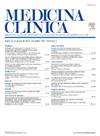Clinical factors influencing the systolic blood pressure benefits of once-weekly semaglutide in patients with type 2 diabetes
IF 2.1
4区 医学
Q1 MEDICINE, GENERAL & INTERNAL
引用次数: 0
Abstract
Introduction
Type 2 diabetes mellitus (T2DM), a major cardiovascular risk, is often associated with obesity and hypertension. Once-weekly subcutaneous semaglutide (OWS-Sema) can improve these conditions, but factors influencing blood pressure (BP) effects are not well studied. This study aimed to assess the impact of OWS-Sema on systolic BP (SBP) and identify clinical factors associated with its reduction in patients with T2DM.
Methods
Sub-analysis of the REALSEM-SP study involving OWS-Sema-naïve patients with T2DM. Changes in SBP and diastolic BP (DBP) and influencing factors were analyzed over 12 months.
Results
One hundred seventy-eight patients were included (mean age 61 ± 10 years, 43.8% female, 79.2% with hypertension). Median baseline SBP and DBP were 132 [122–145] and 80 [72–88] mmHg, respectively. SBP decreased by −4 mmHg at 6 months and −2 mmHg at 12 months (p = 0.014), while DBP showed no significant change (p = 0.395). Factors independently associated with SBP reduction at 6 months included uncontrolled BP and a glomerular filtration rate ≥60 mL/min/1.73 m2, while at 12 months, only uncontrolled BP remained significant. A SBP ≥10 mmHg reduction was associated with uncontrolled BP, dyslipidemia and renal function at 6-month, and only with uncontrolled BP at 12-month.
Conclusion
OWS-Sema was associated with significant reductions in office SBP in T2DM patients, especially those with uncontrolled baseline BP, independent of BMI changes or dose. Patients with baseline uncontrolled BP appear to benefit the most.
影响每周一次西马鲁肽治疗2型糖尿病患者收缩压益处的临床因素
2型糖尿病(T2DM)是一种主要的心血管疾病,通常与肥胖和高血压有关。每周一次皮下注射西马鲁肽(OWS-Sema)可以改善这些情况,但影响血压(BP)效果的因素尚未得到很好的研究。本研究旨在评估OWS-Sema对T2DM患者收缩压(SBP)的影响,并确定与其降低相关的临床因素。方法对OWS-Sema-naïve T2DM患者的REALSEM-SP研究进行亚组分析。分析12个月内收缩压、舒张压变化及影响因素。结果共纳入178例患者,平均年龄61±10岁,女性43.8%,高血压79.2%。中位基线收缩压和舒张压分别为132[122-145]和80 [72-88]mmHg。收缩压在6个月时下降- 4 mmHg,在12个月时下降- 2 mmHg (p = 0.014),而舒张压无显著变化(p = 0.395)。与6个月时收缩压降低独立相关的因素包括未控制的血压和肾小球滤过率≥60 mL/min/1.73 m2,而在12个月时,只有未控制的血压仍然显著。收缩压降低≥10 mmHg与6个月时血压不控制、血脂异常和肾功能相关,仅与12个月时血压不控制相关。结论ows - sema与2型糖尿病患者办公室收缩压的显著降低有关,特别是那些基线血压不受控制的患者,与BMI变化或剂量无关。基线血压不受控制的患者似乎获益最多。
本文章由计算机程序翻译,如有差异,请以英文原文为准。
求助全文
约1分钟内获得全文
求助全文
来源期刊

Medicina Clinica
医学-医学:内科
CiteScore
3.10
自引率
5.10%
发文量
295
审稿时长
22 days
期刊介绍:
Medicina Clínica, fundada en 1943, es una publicación quincenal dedicada a la promoción de la investigación y de la práctica clínica entre los especialistas de la medicina interna, así como otras especialidades. Son características fundamentales de esta publicación el rigor científico y metodológico de sus artículos, la actualidad de los temas y, sobre todo, su sentido práctico, buscando siempre que la información sea de la mayor utilidad en la práctica clínica.
 求助内容:
求助内容: 应助结果提醒方式:
应助结果提醒方式:


